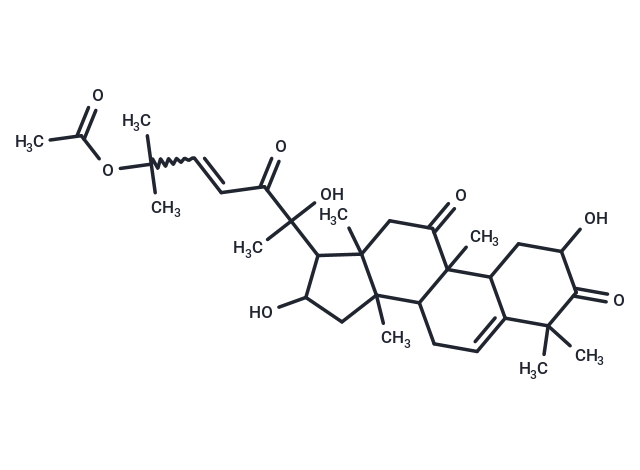Shopping Cart
Remove All Your shopping cart is currently empty
Your shopping cart is currently empty
Cucurbitacin B (Cuc B) has profound in vitro and in vivo antiproliferative effects against human pancreatic Y cells. It inhibited AKT signaling activation through up-regulation of PTEN. Cucurbitacin B is an effective inhibitor of HIF-1 and provide new perspectives into the mechanism of its anticancer activity. Cucurbitacin B inhibits proliferation and induces apoptosis via STAT3 pathway inhibition in A549 lung Y cells.

| Pack Size | Price | USA Warehouse | Global Warehouse | Quantity |
|---|---|---|---|---|
| 1 mg | $44 | In Stock | In Stock | |
| 5 mg | $97 | In Stock | In Stock | |
| 10 mg | $167 | In Stock | In Stock | |
| 25 mg | $337 | In Stock | In Stock | |
| 50 mg | $597 | In Stock | In Stock | |
| 100 mg | $798 | In Stock | In Stock | |
| 1 mL x 10 mM (in DMSO) | $119 | In Stock | In Stock |
| Description | Cucurbitacin B (Cuc B) has profound in vitro and in vivo antiproliferative effects against human pancreatic Y cells. It inhibited AKT signaling activation through up-regulation of PTEN. Cucurbitacin B is an effective inhibitor of HIF-1 and provide new perspectives into the mechanism of its anticancer activity. Cucurbitacin B inhibits proliferation and induces apoptosis via STAT3 pathway inhibition in A549 lung Y cells. |
| In vitro | Cucurbitacin B inhibits the growth of 5 GBM cell lines: U87, U118, U343, U373 and T98 g by affecting the cytoskeleton and the JNK pathway, with ED50 ranged from 5 nM to 100 nM. Cucurbitacin B also causes cell cycle arrest at the G2/M phase, decreases cell migration and induces apoptosis of GBM cells. [1] In human breast cancer cell lines, Cucurbitacin B also inhibits cell growth with ED50 varied from 30.3 nM to 418 nM, and rapidly induces cytoskeletal disruption. [2] In addition, Cucurbitacin B possesses immunomodulatory and anti-inflammatory effects, depending on the induction of heme oxygenase-1 expression via Nrf2 activation. [3] |
| In vivo | In nude mice bearing MDA-MB-231 tumors, Cucurbitacin B (1 mg/kg, i.p.) inhibits tumor growth by 55 %, and causes lower serum glucose levels. [2] |
| Cell Research | For proliferation measurements, the cells are placed into 96 well plates, and cell growth is measured at various times by MTT assay according to the protocol.(Only for Reference) |
| Synonyms | DATISCACIN, Cuc B, Amarine |
| Molecular Weight | 558.7 |
| Formula | C32H46O8 |
| Cas No. | 6199-67-3 |
| Smiles | CC(=O)OC(C)(C)C=CC(=O)C(C)(O)C1C(O)CC2(C)C3CC=C4C(CC(O)C(=O)C4(C)C)C3(C)C(=O)CC12C |
| Relative Density. | 1.0953 g/cm3 (Estimated) |
| Storage | Powder: -20°C for 3 years | In solvent: -80°C for 1 year | Shipping with blue ice/Shipping at ambient temperature. | ||||||||||||||||||||||||||||||||||||||||
| Solubility Information | DMSO: 144 mg/mL (257.74 mM), Sonication is recommended. Chloroform, Dichloromethane, Ethyl Acetate: Soluble Ethanol: 50 mg/mL (89.49 mM), Sonication is recommended. | ||||||||||||||||||||||||||||||||||||||||
| In Vivo Formulation | 10% DMSO+40% PEG300+5% Tween 80+45% Saline: 4 mg/mL (7.16 mM), Sonication is recommended. Please add the solvents sequentially, clarifying the solution as much as possible before adding the next one. Dissolve by heating and/or sonication if necessary. Working solution is recommended to be prepared and used immediately. The formulation provided above is for reference purposes only. In vivo formulations may vary and should be modified based on specific experimental conditions. | ||||||||||||||||||||||||||||||||||||||||
Solution Preparation Table | |||||||||||||||||||||||||||||||||||||||||
Ethanol/DMSO
DMSO
| |||||||||||||||||||||||||||||||||||||||||
| Size | Quantity | Unit Price | Amount | Operation |
|---|

Copyright © 2015-2025 TargetMol Chemicals Inc. All Rights Reserved.